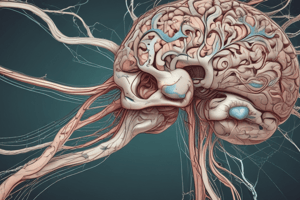Podcast
Questions and Answers
El sistema nervioso central (SNC) se encuentra protegido por la barrera hematoencefálica, una barrera especializada que filtra toxinas y sustancias extrañas.
El sistema nervioso central (SNC) se encuentra protegido por la barrera hematoencefálica, una barrera especializada que filtra toxinas y sustancias extrañas.
True (A)
El sistema nervioso periférico (SNP) se encarga de controlar los movimientos voluntarios.
El sistema nervioso periférico (SNP) se encarga de controlar los movimientos voluntarios.
False (B)
Los neurotransmisores son moléculas de proteínas que transmiten señales entre neuronas.
Los neurotransmisores son moléculas de proteínas que transmiten señales entre neuronas.
False (B)
La función principal del sistema nervioso autónomo (SNA) es controlar los movimientos voluntarios.
La función principal del sistema nervioso autónomo (SNA) es controlar los movimientos voluntarios.
El axón es la parte de la neurona que recibe señales de otras neuronas.
El axón es la parte de la neurona que recibe señales de otras neuronas.
La serotonina es un neurotransmisor involucrado en la regulación del ritmo cardíaco.
La serotonina es un neurotransmisor involucrado en la regulación del ritmo cardíaco.
El sistema nervioso somático (SNS) se encarga de controlar las acciones involuntarias.
El sistema nervioso somático (SNS) se encarga de controlar las acciones involuntarias.
La interpretación de la información sensorial es una función del sistema nervioso periférico (SNP).
La interpretación de la información sensorial es una función del sistema nervioso periférico (SNP).
El dopamine es un neurotransmisor involucrado en la regulación de la presión arterial.
El dopamine es un neurotransmisor involucrado en la regulación de la presión arterial.
El sistema nervioso central (SNC) se encarga de controlar las funciones corporales, como el ritmo cardíaco y la presión arterial.
El sistema nervioso central (SNC) se encarga de controlar las funciones corporales, como el ritmo cardíaco y la presión arterial.
Flashcards are hidden until you start studying
Study Notes
Overview
- The nervous system is a complex system that allows the body to respond to stimuli, interpret sensations, and control movements.
- It consists of two main parts: the Central Nervous System (CNS) and the Peripheral Nervous System (PNS).
Central Nervous System (CNS)
- Consists of the brain and spinal cord
- Responsible for:
- Integrating and processing information from sensory receptors
- Controlling voluntary movements
- Regulating body functions (e.g., heart rate, blood pressure)
- Facilitating thought, perception, and behavior
- Protected by the blood-brain barrier, a specialized barrier that filters out toxins and foreign substances
Peripheral Nervous System (PNS)
- Consists of nerves that connect the CNS to the rest of the body
- Divided into two subsystems:
- Somatic Nervous System (SNS): responsible for transmitting sensory information from the body to the CNS and motor signals from the CNS to muscles and glands
- Autonomic Nervous System (ANS): responsible for controlling involuntary actions, such as:
- Heart rate
- Blood pressure
- Digestion
- Respiration
- Pupil dilation
Nerve Cells (Neurons)
- Basic structural and functional units of the nervous system
- Consist of:
- Dendrites: receive signals from other neurons
- Cell body: contains the nucleus and maintains the cell's functions
- Axon: transmits signals to other neurons or to muscles or glands
- Communication between neurons occurs through:
- Synapses: small gaps between neurons where chemical signals (neurotransmitters) are transmitted
Neurotransmitters
- Chemical messengers that transmit signals between neurons
- Examples:
- Acetylcholine: involved in muscle contraction and memory formation
- Dopamine: involved in motivation, reward, and movement
- Serotonin: involved in mood regulation and appetite
Functions of the Nervous System
- Control and coordination of body movements
- Regulation of body functions (e.g., heart rate, blood pressure)
- Interpretation and response to sensory information
- Facilitation of thought, perception, and behavior
- Regulation of emotions and mood
Sistema Nervioso
- El sistema nervioso es un sistema complejo que permite al cuerpo responder a estímulos, interpretar sensaciones y controlar movimientos.
Sistema Nervioso Central (SNC)
- Está formado por el cerebro y la médula espinal
- Responsable de:
- Integrar y procesar información de receptores sensoriales
- Controlar movimientos voluntarios
- Regular funciones corporales (por ejemplo, frecuencia cardíaca, presión arterial)
- Facilitar pensamiento, percepción y comportamiento
- Protegido por la barrera hematoencefálica, una barrera especializada que filtra toxinas y sustancias extrañas
Sistema Nervioso Periférico (SNP)
- Está formado por nervios que conectan el SNC con el resto del cuerpo
- Dividido en dos subsistemas:
- Sistema Nervioso Somático (SNS): responsable de transmitir información sensorial del cuerpo al SNC y señales motoras del SNC a músculos y glándulas
- Sistema Nervioso Autónomo (SNA): responsable de controlar acciones involuntarias, como:
- Frecuencia cardíaca
- Presión arterial
- Digestión
- Respiración
- Dilatación pupilar
Células Nerviosas (Neuronas)
- Unidades estructurales y funcionales básicas del sistema nervioso
- Consisten en:
- Dendritas: reciben señales de otras neuronas
- Cuerpo celular: contiene el núcleo y mantiene las funciones de la célula
- Axón: transmite señales a otras neuronas o a músculos o glándulas
- La comunicación entre neuronas ocurre a través de:
- Sinapsis: pequeñas brechas entre neuronas donde se transmiten señales químicas (neurotransmisores)
Neurotransmisores
- Mensajeros químicos que transmiten señales entre neuronas
- Ejemplos:
- Acetilcolina: involucrada en la contracción muscular y formación de memoria
- Dopamina: involucrada en la motivación, recompensa y movimiento
- Serotonina: involucrada en la regulación del estado de ánimo y apetito
Funciones del Sistema Nervioso
- Control y coordinación de movimientos corporales
- Regulación de funciones corporales (por ejemplo, frecuencia cardíaca, presión arterial)
- Interpretación y respuesta a información sensorial
- Facilitación del pensamiento, percepción y comportamiento
- Regulación de emociones y estado de ánimo
Studying That Suits You
Use AI to generate personalized quizzes and flashcards to suit your learning preferences.




